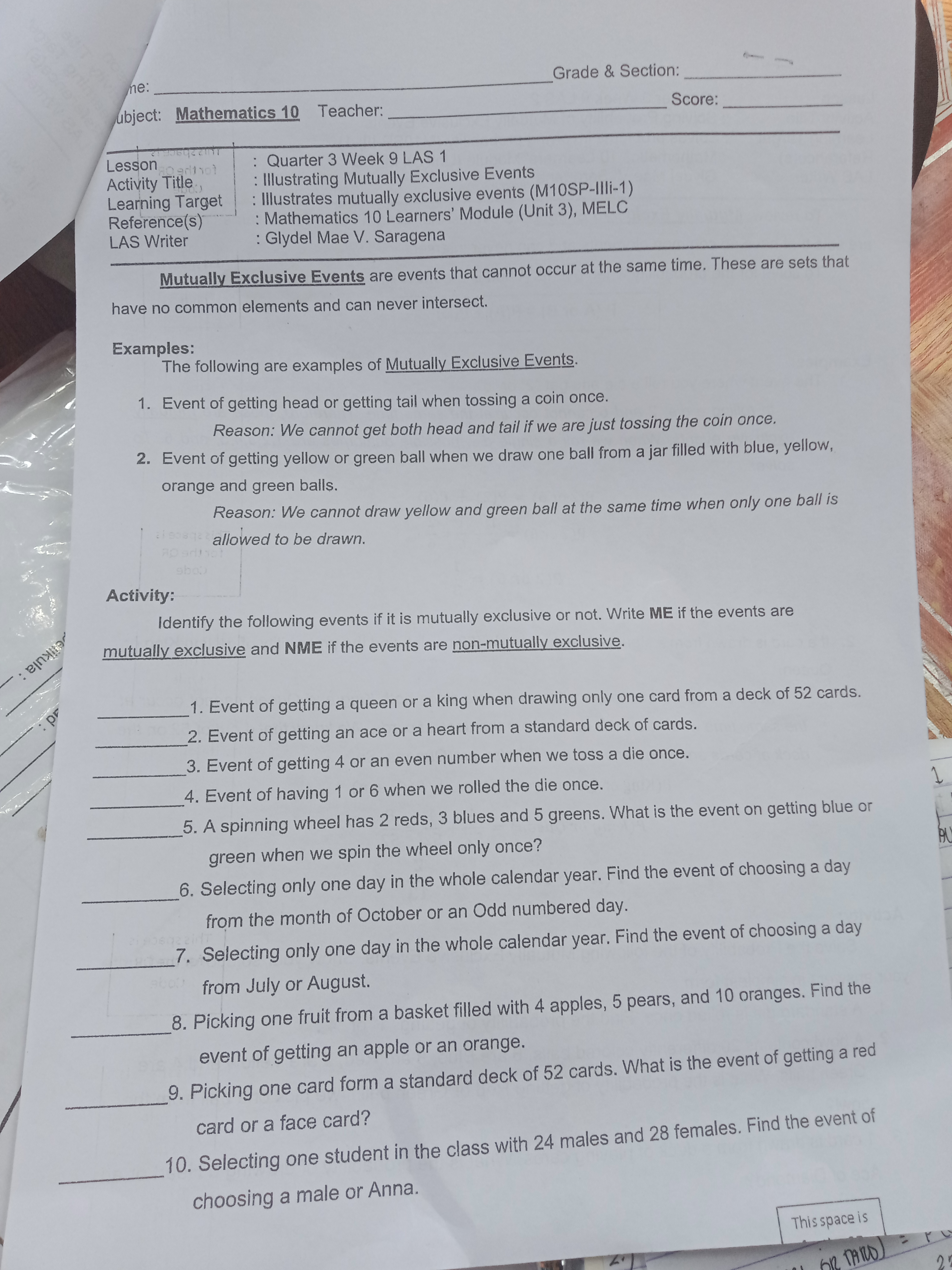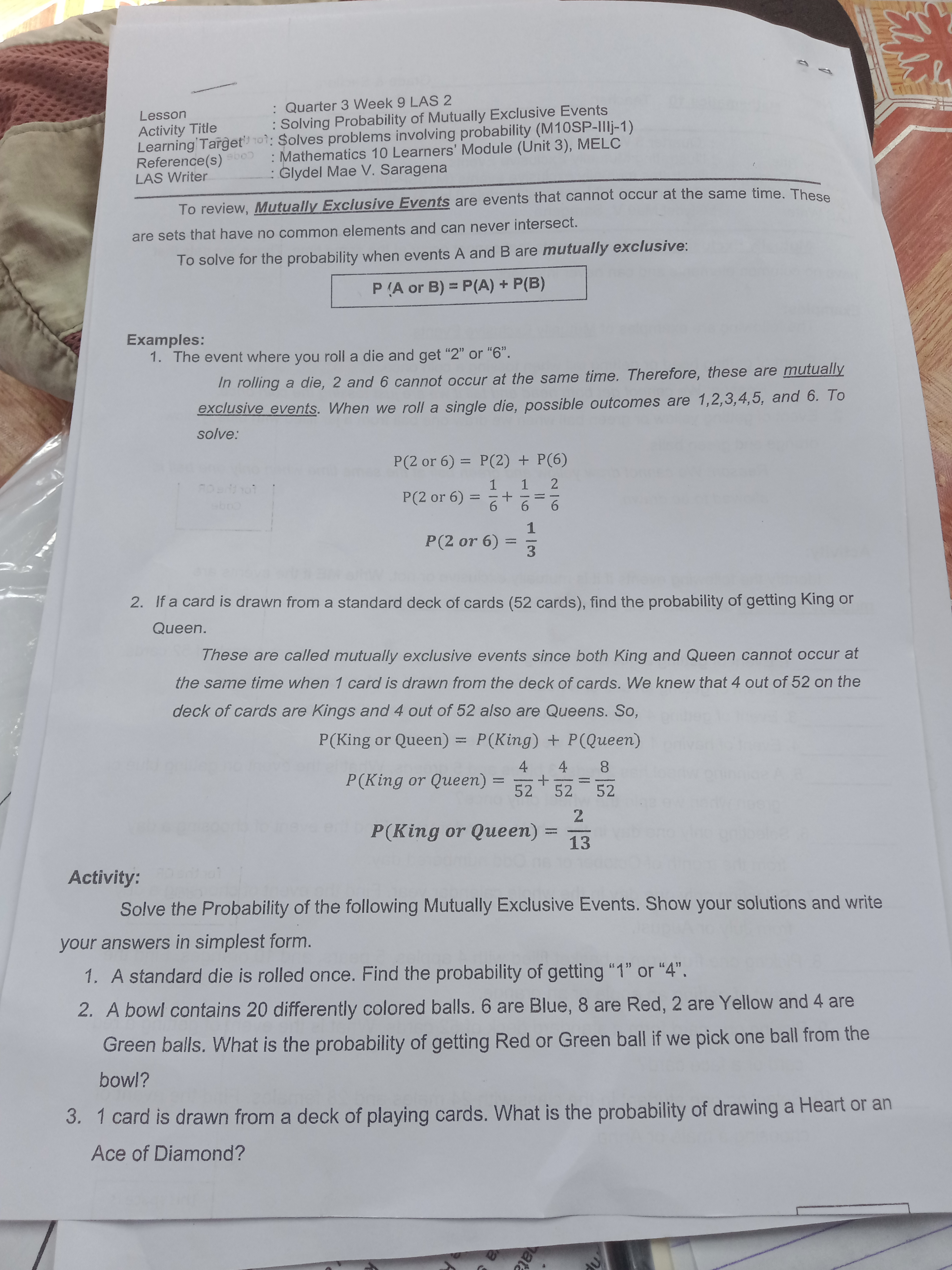Kailangan ko po ang inyong tulong.
sson : Quarter 3 Week 8 LAS 2 Ctivity Title : Union and Intersection of Events Learning Target : Finds the probability of (AUB) of not mutually exclusive events. Reference(s) : Mathematics 10 Learners Module p.335-337, MELC (M10SP-Illg-h-1) LAS Writer : Shiela Mae P. Tito If two events, A and B are not mutually exclusive, the probability of (AUB) is the sum of their probabilities decreased by the probability of both occurring. In symbol, P(AUB) = P(A) + P(B) - P(AnB). Example: A class is composed of 80 students. 24 are members of the glee club, 36 are on the honor rolls and 28 are members of the glee club and are also in the honor rolls. What is the probability that a randomly selected student is a part of the glee club and is also in the honor roll list? Solution: P(AUB ) = P(A) + P(B) - P(AnB) 24 36 28 80 80 80 (24+36) 80 80 Therefore, the probability that a randomly selected student is a member of the glee club and is also in the honor roll list is Activity Given a not mutually exclusive event below, find the probability of (AUB). 1. Ruby's dog has 8 puppies. The puppies include white females, 3 mixed-color females, 1 white male and 2 mixed-color males. Ruby wants to keep one puppy. What is the probability that she randomly chooses: e. female and white f. mixed-color and malene: Grade & Section: ubject: Mathematics 10 Teacher: Score: Lesson : Quarter 3 Week 9 LAS 1 Activity Title : Illustrating Mutually Exclusive Events Learning Target : Illustrates mutually exclusive events (M10SP-Illi-1) Reference(s) : Mathematics 10 Learners' Module (Unit 3), MELC LAS Writer : Glydel Mae V. Saragena Mutually Exclusive Events are events that cannot occur at the same time. These are sets that have no common elements and can never intersect. Examples: The following are examples of Mutually Exclusive Events. 1. Event of getting head or getting tail when tossing a coin once. Reason: We cannot get both head and tail if we are just tossing the coin once. 2. Event of getting yellow or green ball when we draw one ball from a jar filled with blue, yellow, orange and green balls. Reason: We cannot draw yellow and green ball at the same time when only one ball is : 1 89 allowed to be drawn. Activity: Identify the following events if it is mutually exclusive or not. Write ME if the events are Gikula : mutually exclusive and NME if the events are non-mutually exclusive. DV 1. Event of getting a queen or a king when drawing only one card from a deck of 52 cards. 2. Event of getting an ace or a heart from a standard deck of cards. 3. Event of getting 4 or an even number when we toss a die once. 4. Event of having 1 or 6 when we rolled the die once. 5. A spinning wheel has 2 reds, 3 blues and 5 greens. What is the event on getting blue or green when we spin the wheel only once? 6. Selecting only one day in the whole calendar year. Find the event of choosing a day from the month of October or an Odd numbered day. 7. Selecting only one day in the whole calendar year. Find the event of choosing a day from July or August. 8. Picking one fruit from a basket filled with 4 apples, 5 pears, and 10 oranges. Find the event of getting an apple or an orange. 9. Picking one card form a standard deck of 52 cards. What is the event of getting a red card or a face card? 10. Selecting one student in the class with 24 males and 28 females. Find the event of choosing a male or Anna. This space isLesson : Quarter 3 Week 9 LAS 2 Activity Title : Solving Probability of Mutually Exclusive Events Learning Target' 101: Solves problems involving probability (M10SP-Illj-1) Reference(s) 905 : Mathematics 10 Learners' Module (Unit 3), MELC LAS Writer : Glydel Mae V. Saragena To review, Mutually Exclusive Events are events that cannot occur at the same time. These are sets that have no common elements and can never intersect. To solve for the probability when events A and B are mutually exclusive: P (A or B) = P(A) + P(B) Examples: 1. The event where you roll a die and get "2" or "6". In rolling a die, 2 and 6 cannot occur at the same time. Therefore, these are mutually exclusive events. When we roll a single die, possible outcomes are 1,2,3,4,5, and 6. To solve: P (2 or 6) = P(2) + P(6) P ( 2 or 6 ) = 1_ P(2 or 6) = 2. If a card is drawn from a standard deck of cards (52 cards), find the probability of getting King or Queen. These are called mutually exclusive events since both King and Queen cannot occur at the same time when 1 card is drawn from the deck of cards. We knew that 4 out of 52 on the deck of cards are Kings and 4 out of 52 also are Queens. So, P(King or Queen) = P(King) + P(Queen) 4 4 8 P(King or Queen) = 52 + 52 -52 P(King or Queen) = 2 13 Activity: Solve the Probability of the following Mutually Exclusive Events. Show your solutions and write your answers in simplest form. 1. A standard die is rolled once. Find the probability of getting "1" or "4". 2. A bowl contains 20 differently colored balls. 6 are Blue, 8 are Red, 2 are Yellow and 4 are Green balls. What is the probability of getting Red or Green ball if we pick one ball from the bowl? 3. 1 card is drawn from a deck of playing cards. What is the probability of drawing a Heart or an Ace of Diamond









